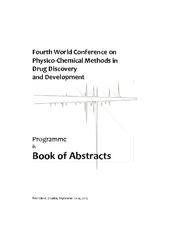Prikaz osnovnih podataka o dokumentu
Human serum albumin binding of certain antimalarials
| dc.creator | Marković, Olivera S. | |
| dc.creator | Cvijetić, Ilija | |
| dc.creator | Zlatović, Mario | |
| dc.creator | Opsenica, Igor | |
| dc.creator | Terzić-Jovanović, Nataša | |
| dc.creator | Šolaja, Bogdan A. | |
| dc.creator | Verbić, Tatjana | |
| dc.date.accessioned | 2022-06-16T08:45:34Z | |
| dc.date.available | 2022-06-16T08:45:34Z | |
| dc.date.issued | 2015 | |
| dc.identifier.uri | http://cherry.chem.bg.ac.rs/handle/123456789/5323 | |
| dc.description.abstract | Tested compounds, previously synthesized, are derivatives of chloroquine, drug commonly used in the treatment and prevention of malaria. Human serum albumin (HSA) has the role in transport of endogenous (fatty acids, hormones, bile acids, amino acids) and exogenous compounds (drug molecules and nutrients). Interaction between tested compounds and HSA has been studied by fluorescence spectroscopy in phosphate buffered saline (1× PBS, pH 7.4) [1]. Results show that among tested compounds, all positively charged at pH 7.4, derivatives with thiophene substructure bind to HSA. Molecular docking studies were used to determine HSA–compound binding mode. Fluorescence quenching data were processed using Stern-Volmer (S-V) equation [2]. Almost linear S-V plot for binding of 1 to HSA (Fig. 1a) indicates single type of quenching mechanism. Results show that Ksv decreases (20C: (2.60±0.07)×105 M -1 ; 25C: (2.33±0.07)×105 M -1 and 37C: (2.18±0.08)×105 M -1 ) as temperature increases indicating static quenching mechanism. Downward curvature in S-V plots of 2 and 3 (Fig. 1b and 1c) indicates that tryptophan residues are not fully accessible to the drug and that dynamic quenching dominates over static. Fraction of tryptophan residues that are buried and inaccessible to the quencher and effective quenching constants can be determined by modified S-V equation. The effective quenching constant for 2 and 3 increases as temperature increases, this is another indication that dynamic quenching process is dominant in binding of 2 and 3 to HSA. Effective quenching constants of all three compounds are in the order of 10 5 M-1, meaning that these compounds can be effectively carried and stored by HSA in the human body. | sr |
| dc.language.iso | en | sr |
| dc.relation | info:eu-repo/grantAgreement/MESTD/Basic Research (BR or ON)/172008/RS// | sr |
| dc.relation | info:eu-repo/grantAgreement/EC/FP7/256716/EU// | sr |
| dc.rights | openAccess | sr |
| dc.rights.uri | https://creativecommons.org/licenses/by/4.0/ | |
| dc.source | 4th World Conference on Physico-Chemical Methods in Drug Discovery and Development, Red Island, Croatia, September 21-24, 2015 | sr |
| dc.title | Human serum albumin binding of certain antimalarials | sr |
| dc.type | conferenceObject | sr |
| dc.rights.license | BY | sr |
| dc.citation.spage | 67 | |
| dc.citation.epage | 67 | |
| dc.type.version | publishedVersion | sr |
| dc.identifier.fulltext | http://cherry.chem.bg.ac.rs/bitstream/id/29528/bitstream_29528.pdf | |
| dc.identifier.rcub | https://hdl.handle.net/21.15107/rcub_cherry_5323 |


